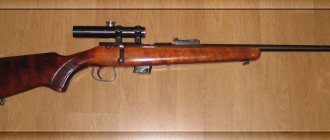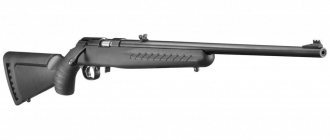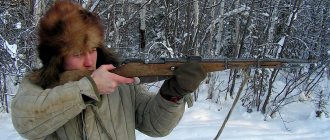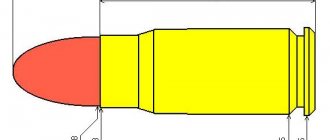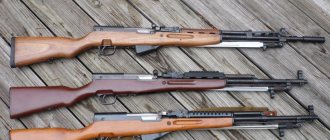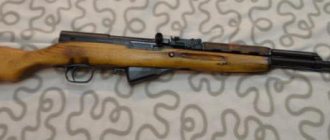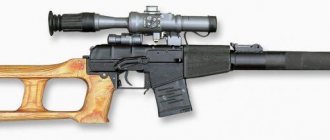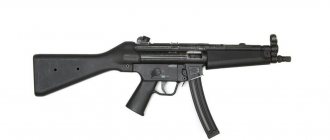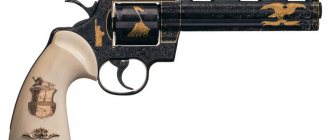Why do you need a small caliber?
Small caliber weapons are a good example of the fact that the main factor in shooting accuracy is not the weapon, but the type of ammunition. The development of the .22 LR cartridge led to a significant reduction in the cost of the shot, and the structural feature of the side-ignition cartridge case allowed engineers to create more than 10 types of cartridges, for which special guns were subsequently created.
Types of 5.6 mm cartridges
With all their variety, the most popular small-caliber side-fire cartridges are .22 LR and .22 WMR. The first type was invented and first released more than a century ago. During this time, he gained worldwide popularity, becoming the record holder for the number of shots fired. Its full name can be represented as follows: a 22-caliber cartridge, with a bullet diameter of 5.6 mm, L - long, R - rifle, as it has a rim on the bottom of the cartridge case.
Since “small” cartridges have a fairly low energy generated after a shot, and the trajectory of the bullet changes greatly, they are used for shooting at a short distance from the target. Mostly professional hunters use them to shoot small animals (rodents and birds).
In Russia, sables and squirrels are hunted using small cartridges; in the United States, ground squirrels are shot with them.
A lot of different types of weapons are produced for the .22 LR caliber - carbines, pistols, and even machine guns.
The second popular small cartridge - .22 LR (full name .22 Winchester Magnum Rimfire) - is produced for civilian use. This caliber was especially loved in the USA. This cartridge was invented in 1959 for hunting larger animals, such as coyotes or jackals. The use of such a cartridge for smaller animals does not make sense, since the ammunition severely damages the body of the victim.
Also, both types of “small guns” are actively used when teaching shooting to beginners, since ammunition of this type is low in cost.
Rifle. (Part 5) 22 LR (5.6x15.5)
Rifled weapons continued.
GUEST.
RIM FIRE CARTRIDGES 22 LR (5.6x15.5)
“Melkashka,” as he is lovingly called, is an elegant baby with enormous potential. The cartridge of an athlete and hunter, an excellent tool for training. The family of rimfire cartridges includes the most common types of ammunition, such as 22 Short (Short - shortened pistol); 22 Long Rifle (Long Rifle - long rifle) and 22 WMR (Winchester Magnum Rimfire). The caliber is 5.6 mm (0.22 inches). The small-caliber cartridge is intended for sports and hunting and takes its place in the general range of ammunition. The initial speed of a bullet for different types of cartridges can range from 300 to 400 and even 450 m/sec. They are used for shooting at ranges up to 100 meters. The material used in MK bullets is an alloy of lead and antimony. The bullet is coated with a paraffin-based lubricant. It performs two functions - lubrication as such and sealing the cartridge to prevent breakthrough of powder gases. The current production volume of 22 LR cartridges significantly exceeds the production volume of any other type of ammunition. There are many varieties of this type of cartridge with lead bullets and brass or steel casings. Domestic rifle cartridges go by different names - “Temp”, “Junior”. "Marmot", "Sable"; sports - "Biathlon"; or high-quality “Extra”, “Olympus”.
Foreign cartridges in the name usually carry the caliber - 22 LR and characteristics of speed and type of bullet. For example: 22 LR HV Hohlshitz or 22 LR HV Hollow Point are high-velocity cartridges with a hollow-point bullet with a hole in the head. The maximum range of a bullet when fired at an angle of 30 degrees reaches 1.5 km and is considered dangerous. However, if you place the barrel of a weapon parallel to the surface of the earth, then a bullet fired from this barrel will fly about 150 m and hit the ground at a speed of about 250 m/s, i.e. the horizontal range of the bullet is small due to the low initial speed. The cartridge has a low initial bullet speed, even when galvanizing a lead bullet with copper or its alloys, as is done with the 22 LR HV and 22 LR Super Velocity cartridges, it does not allow the initial speed of a bullet weighing 2.6 g to be raised to more than 450 m/sec. Therefore, the bullet’s flight path is quite steep, which means that even small errors in determining the distance to the target, opposite the one at which the weapon was aimed, lead to a guaranteed miss.
At the dawn of my first hunts, I met many good people and specialists, for which I am grateful to them to this day. When I decided to buy a “small thing” for training and shooting, the question arose, what to choose? I was recommended the combined “Belka” (barrel length 65 cm) or “Sever” (barrel length 60 cm), or another barrel, but with a barrel length of at least 60 cm. Why?
Firstly: for my ambushes, use a smooth trunk, then 30 meters and up to 100 m. MK, because Hunting with the “small fish” was prohibited; I had legal grounds to be with her in the hunting grounds.
Secondly: already at that time a lot of research was carried out on the rimfire cartridge, our specialists drew up a schedule (pressure, barrel length, speed).
It follows from this that the pressure reaches its maximum value immediately behind the chamber in the first 5-7 cm of the barrel length. As the gunpowder burns, it rapidly drops by 45 cm in length, reaching approximately 250 kgf/sq.cm., goes into a smooth decline and at a distance of 62-68 cm. has a minimum value of about 200 kgf/sq.cm. If you look at the speed line, then despite the fast-burning gunpowder, the speed does not increase very rapidly and approaches the maximum value only after traveling 60 cm along the barrel. The dependence of the initial speed on the length of the barrel is very clearly and clearly visible. Simply put, for shooters it’s all the same - the target is 50 m away from you and that’s it, shoot. But on a hunt it’s different, a fox or a black grouse can appear at 30 or 80 meters, and for a more confident shot, the speed, trajectory and energy of the bullet are important, because you need a trophy. Nevertheless, our TOZs have a barrel length of 536 mm, it was very much appreciated, it is heavy and has a long barrel. “Belka” was especially good. The “North” is good because it has a rifled upper barrel (the line of the barrel and optics are closer to each other), but the Tula combined one has a rifled lower barrel. It's up to you to choose, shoots are one thing, hunting is another. Or you can have one, but for some purposes and for other purposes.
One more circumstance. As you know, the burning of gunpowder continues in the bore; in winter, its intensity decreases, because the barrel also needs to be heated. Hence the incomplete combustion of gunpowder, which leads to a decrease in the initial speed of the bullet. That's why, . In a bolt-action weapon, this can be done without a click, but in a bolt-action weapon, only with the movement of the bolt. When quickly aiming while hunting, during which there is no time to move the clamp and set it to the desired distance, use a fixed sight. Also, there is no time to click on the optical sight - you need to know the trajectory of the bullet (decrease-exceed). It is most profitable to shoot this cartridge at a distance of 100 meters. Why? Because in this case the trajectory of the bullet relative to the aiming line will be higher. “Playing” with the front sight or aiming 10 cm below the target, an accurate hit on the target is ensured at all three distances. But the most important thing is that you will always see this target, it will be above the sight. When zeroing at 50 m, at 25 m the bullet will land 4 cm higher, and at 75 m it will land 9 cm lower, while at a longer distance you will not see the target. The small-caliber rifle has served and continues to serve in hunting for decades. The main targets for shooting remain sable, marten, squirrel, and hazel grouse. The capabilities of this cartridge can be somewhat expanded by increasing the initial speed of the bullet and changing its design, which is what is done in modern cartridges - the bullets are clad with a copper alloy, which allows increasing the initial speed to 450 m/sec, and the bullets are made with a hole in the nose. Unfortunately, mainly in the West, focusing not only on squirrel, marten, ground squirrel, but also on larger animals - marmot, jackal, coyote, fox. capercaillie. You can call it Dynamit Nobel - Subsonic; CCI - Stinger; Lapua - Hollowpoint; Eley - Subsonic Hollow point. Our Klimovskaya produces good cartridges “Cowboy”, Novosibirsk. Unfortunately, the release of the “Lynx” has not been mastered, and this cartridge, due to the special shape of the hole, had a stopping effect at the level of a combat pistol cartridge. When hunting with such a cartridge, you can be sure that there will be no wounded animals. Either a miss or a catch. But we don’t do it, so others will. And we will be “tailing behind” again. High-speed cartridges on the packaging are marked HV (High Velocity) or HS (High Speed) - “high speed”, which is 385-400 m/s, they are clad with copper and are distinguished by their yellow color. Note that although the difference between high-speed and standard cartridges does not seem very large, when shooting at a distance of 75-100 m, high-speed cartridges have a significant advantage, although in terms of accuracy they are slightly inferior to sports ones. High-velocity cartridges are marked "
“, they have shortened bullets weighing 1.9 - 2.4 g. and brass sleeves extended to 17.6 mm. Bullets must be galvanized with copper or its alloys. As a result of weight reduction, durable galvanic coating and lengthening of the cartridge case, the initial speeds of bullets were raised to 500 m/s or more. High-velocity cartridges have a definite advantage in the form of a flatter trajectory at distances up to 75 m, at longer distances the speed and energy of their bullets becomes slightly higher or comparable to the bullets of HV cartridges. However, in terms of accuracy, these cartridges are significantly inferior to standard ones. In 1959, Winchester developed the 22 WMR cartridge, its case length is 26.72 mm versus 15.5 for the 22 LR, and the speed is up to 670 m/s. Since lead bullets break off the rifling at speeds over 400 m/s, the 22 WMR bullets have a thin copper or copper alloy jacket. The cartridge is very effective at a distance of up to 120 meters. Although it is not widespread, especially in our country. To diversify the text, I am attaching photographs: In the photo: M - 1, 2, 3, 4 - the most frequently used cartridges by me. Among the domestic ones, I think the “Cowboy” is the best - I advise you to cut the front part of the bullet crosswise with a blade. From foreign RWS HV, it is also advisable to cut the front part. Out of competition for hunting - Winchester SUPER-X, the crow has no chance up to 100 m, the black grouse and fox (I guess) have no chance up to 60-70 m. But photo: O - 14, 24, 25 “North” for hunting and shooting. We don’t stop training in the summer. In the photo: S - 0 sniper SV - 99 and S - 1 multi-shot MZ for shoots, S - 4 TOZ-12 for shoots and is suitable for hunting. In the photo: P - 3, 8, 10 - optical sight reticles, the most practical for small-caliber weapons.
M 1
M 2
M 3
M 4
O 14
O 24
O 25
C 0
C 1
C 4 P 3 P 8
P 10
(TO BE CONTINUED)
I wish everyone well. Happy hunting. “No fluff, no feather” With respect to you, VASILICH.
Related Posts:
- Six rifles and two cartridges. OCD "Ugolek"
- Master Chef Celebrity 1 issue part 1 from June 12…
- And the black knife plunged into the fascist
- Israel will expand its hotel sector by 1,675 rooms...
- Master Chef Celebrity 1 issue part 2 from June 12…
- A rare portrait of Catherine I has joined the collection...
Permission to fire the .22 LR cartridge
Obtaining permission to shoot small-caliber weapons is no different from obtaining permission to use a rifled barrel. The hunter must collect and provide the following documents to the LRO:
- Hunting license.
- Certificate of passing a medical examination.
- A report drawn up by the local police officer, which contains information about the conditions for storing firearms.
Also, do not forget that only those persons who have five years of experience in handling a smooth-bore gun can obtain a permit for rifled weapons.
Why 22LR anyway?
The popularity of this caliber gave rise to a new discipline - “Mini Rifle”, which, in turn, is also divided into classes - semi-automatic and manually reloaded.
Both classes are also divided into “open”, in which any tuning is allowed (optical sights, bipods, compensators, etc.) and “standard”, in which only minimal improvements to the carbine are allowed.
By the way, the “maturity”, seriousness and self-sufficiency of this weapon is also evidenced by the current procedure for obtaining permission to purchase and carry this rifle from the Ministry of Internal Affairs. It's no different from a .338 Lapua Magnum bolt action or a .223 semi-automatic!
In the video below you can see the penetration test of the 22lr cartridge.
Thanks to the relatively low energy of the bullet, you can train and compete in regular shooting ranges and do not have to look for open ranges far from civilization.
A sports shooter spends a lot of time and ammunition preparing for competitions, and a small-caliber cartridge allows the process itself to be much more budget-friendly due to the low retail price.
The ballistics of the cartridge at short and medium distances (up to 50 m) is in no way inferior to its older “brothers”, for example 223Rem, 5.45Х39, 7.62х39, etc., and therefore the “small thing” can also be used in preparation for competitions with rifles larger calibers.
Comparative mass of different types and models of weapons
The light weight, almost complete absence of toss and recoil of the weapon allows girls and young athletes to shoot, thereby popularizing both shooting itself, turning it into a pleasant family leisure activity, and increasing the general weapons culture of citizens.
Comparative characteristics of the mass of different types of long-barreled sporting weapons:
As we remember, recoil not only affects the speed of aimed shooting, but is also extremely contraindicated for junior shooters whose musculoskeletal system is not yet fully formed. And the “small thing” allows teenagers and children to shoot without the slightest risk to their health!
Another interesting factor worth noting is the recoil of the weapon. The little ones don’t have it!
No, how can it not be there... Of course, it is present, but in comparison with the recoil of a carbine of a larger caliber, and even more so with the recoil of a shotgun (!!!), we can safely say that it is not there. Even a 9x19mm pistol throws harder.
It is not surprising, because the procedure for obtaining permission to purchase and store is relatively simple. An inexpensive Turkish gun can be bought for several hundred dollars and, fortunately, the choice is great.
Children and teenagers can shoot the mini-carbine with confidence
It so happened historically in Ukraine that the most popular weapon for dynamic shooting was a shotgun or, as it is officially called, a “smoothbore hunting rifle.”
The next discipline of dynamic shooting, a pistol (revolver), is perhaps the most common and widespread weapon in our sport.
The cartridge is also very affordable. Well, the biggest plus is the opportunity to practice at the shooting ranges of your city.
The combination of these factors has led to the fact that throughout the year we hold several dozen rifle matches of varying complexity and intensity in different regions of Ukraine. If you stop by the Praktika shooting range, in the village. Kapitanivka, near Kiev, on one of the weekends, you will be convinced of the massive scale of any shooting event, even training.
Regarding our hobby, it is precisely the factor of the inaccessibility of the pistol that prevents the development of this interesting shooting direction. Some amateur pistol shooters still get out of the situation by renting weapons in shooting clubs (Ibis, Safari, Dynamo, etc.). But you must admit, is it possible to compare shooting from your own, lovingly maintained, customized weapon with shooting from a rented one? In my practice, there were at least 2 cases when rented pistols seriously let me down at competitions.
In many countries, it is much easier to buy a pistol than a shotgun or carbine. And pistol matches often attract hundreds of shooters! But not in Ukraine...
Unfortunately, current legislation does not allow individuals to buy rifled short-barreled weapons. Paradox! Any law-abiding citizen can buy the most powerful deadly weapon - a 12-gauge shotgun, but a 22LR pistol - not! Where is the logic?... Well, this is a question for the legislator.
What about the carbine, you ask? Of course, and a carbine! No less gambling and driving discipline. Fortunately, the law allows us to buy almost any carbine available in the store. Even .50 (12.7 mm!!!). But we can’t have a gun, no, no, remember?!
9x19 luger pistol cartridge compared to .50BMG cartridge
You can outfit your rifle as your heart desires and your wallet allows - bipods, DTK, forends, optics, handles, silencers and flash hiders, magazines of any capacity, etc.
There is virtually no limit to creativity in tuning and adapting mini carbines
But it ends exactly where the desire to shoot more than 100 m arises...
We can count the number of commercial shooting ranges and shooting ranges with such distances on the fingers of one hand. Are you ready to travel hundreds of kilometers from home for one workout? I doubt.
What is the alternative? Is there light at the end of this slippery tunnel?
Advantages and disadvantages of “small things”
Among the main advantages of using small cartridges, the following factors can be noted:
- low recoil;
- a small hole in the body of the victim, which allows preserving the integrity of the skin;
- low noise level during firing;
- possibility of using a muffler;
- low price and availability of ammunition, which allows hunters to hone their shooting skills.
Disadvantages of the 5.6 mm small cartridge:
- low lethal force;
- the ability to hit only close targets.
Feature of the 5.6 mm cartridge
The 5.6 mm (.22 LR) caliber cartridge got its name because its bullet diameter is 0.22 inches (5.6 mm). This type of ammunition does not have a primer. For a shot to occur, the firing pin strikes the side of the base of the case, which is why it is called a side-fire cartridge.
The 5.6 mm “small” cartridge has a percussion (also called primer) composition pressed into the rim of the cartridge case. When the shooter presses the trigger guard, the percussion mechanism of the gun crushes the rim and the primer composition ignites. As a result of detonation, the main powder charge ignites.
Thanks to the special design, the rim of the 5.6 mm “small” cartridge is easily crushed by the impact of the striker. The walls of the case must have a thin layer of metal, which limits the maximum pressure created as a result of ignition of the gunpowder. If the charge in the cartridge is too powerful, the cartridge case may rupture during firing.
A little history
In the distant 40s of the 19th century, a French gunsmith named Flaubert (yes, that same one!) proposed a new concept to the world shooting community - the rimfire cartridge.
Do not forget that at this time there was a revolution in the world of small arms and there was a clear trend of changing muzzle-loading shotguns, carbines and pistols to weapons chambered for a unitary cartridge and loading from the breech (what we will call the chamber).
And Flaubert and his patron also sought to prove that he could become a worthy successor to the fuses and muskets of past eras.
On the left and center are Flaubert cartridges, on the right is the 22LR cartridge
This cartridge did not have a powder charge, and the shot occurred due to the ignition of the ignition composition pressed into the bottom of the cartridge case. Moreover, the firing pin did not puncture the primer in the center of the bottom of the case, as in the cartridges we are used to, but hit the rim of the case. But this cartridge, despite the different calibers, was quite low-power.
In 1857, the American armory produced the first classic cartridge .22 LR (“LR” - Long Rifle, English). Translated into our metric system, this is 5.6 x 15.6 mm. This cartridge, unlike Flaubert's brainchild, had a powder charge, which made it quite accurate and powerful.
From left to right: Flaubert cartridge, .22 short, .22lr
More than 150 years have passed since then, and the 22LR continues its successful path next to its “bigger” brothers of larger calibers. For more than a century and a half history, this cartridge has been successfully used and continues to be used in rifles, pistols, carbines, various special weapons and even in machine guns (!!!)
Do you remember the TOZ rifles from school shooting ranges and DOSSAF sections? This is the good old “small thing”, 22LR!
It is worth recalling the breadth of the scope of use of weapons in this caliber. 22LR caliber rifles are the most productive rifled hunting weapons of all rifled weapons. Many Olympic shooting sports use this cartridge - biathlon, bullet shooting, etc.
They are used by high-precision athletes. Security forces in developed countries also use 22LR weapons for training and special purposes.
In the Red Army, at the beginning of the last century, the Blum machine gun was used to train infantry, and in the US Army, from the mid-60s, another interesting machine gun was in service - the American-180, also in 22LR caliber.
Blum small-caliber machine gun
American-180 small-caliber machine gun
The concept of a “survival rifle” is also interesting. Imagine, you find yourself in a desert, forest or mountains, and for hundreds of kilometers there is not a single living soul. Or, what’s worse, a zombie apocalypse has occurred... You need to protect yourself from wild animals or the walking dead, or simply get game for food. It will be impossible to do this without weapons. Of course, a 12 gauge shotgun or a 30-06 scoped bolt gun can do the job, too. But, count the weight of the cartridges. Are you sure that you can make a 2-week trek through sand or thicket with 1000 rounds of shotgun or large-caliber carbine ammunition, and even with a backpack, sleeping bag and other equipment? I very much doubt it... But taking the same number of 22LR cartridges “on board” without any problems is no problem.
Henry .22 Survival Rifle, all parts of the rifle fit inside the stock
Characteristics of the .22 LongRifle ammunition
- Caliber - 5.66 mm
- The bullet weight ranges from 1.9 to 2.6 g.
- Bullet weight - 2.72 g.
- The maximum mass of gunpowder is 0.34 g.
- The initial bullet speed is from 325 to 345 m/s.
- The bullet speed at 50 meters from the muzzle is 295 m/s.
- Initial bullet energy - 135 J
- The energy of the bullet after 50 meters of flight is 110 J.
The dimensions of the small cartridge are as follows:
- cartridge length - 25 mm;
- sleeve length - 15.1 mm;
- sleeve diameter in the upper part - 5.75 mm;
- The diameter of the sleeve at the bottom is 7.1 mm.
History of the .22 LR
The 0.22-inch small-bore cartridge was invented in the late 19th century by Stevens Arm & Tool Comp. It was equipped with a 40 grain (2.6 gram) bullet. The total weight of black powder was 0.324 grams. It was not possible to measure the speed of a bullet at that time.
The modern model of ammunition from the Stevens Arm & Tool Comp company has remained virtually unchanged. The sleeve is made of metal, the total length of the cartridge is 25.5 mm. The main difference between the modern cartridge and the 1887 model is only that now the lead bullet is wrapped in a special casing to improve the ballistic characteristics of the ammunition.
Unlike the first developments, the modern bullet used by hunters has a mass of 2.6 grams. When firing from a weapon with a barrel length of 152 mm, the maximum bullet speed after a shot reaches 345 m/s, and the muzzle energy is 140 J. When firing from a rifle with a longer barrel, the bullet speed increases on average by 60 m/s.
In the modern world, 4 rimfire cartridges are produced:
- The most powerful ammunition of them is called Hyper-velocity. When fired, the bullet reaches an ultra-high speed of 425 m/s.
- The second most powerful cartridge is High-velocity. Maximum speed - 400 m/s.
- Side-ignition ammunition with a standard bullet speed (about 343 m/s) is called Standard-velocity.
- A small-caliber cartridge with a subsonic bullet speed (335 m/s) is called Subsonic.
The velocity of a bullet is influenced by many factors, such as the manufacturer of the ammunition, as well as the length of the barrel.
Encyclopedia of weapons
Cartridge .22 LR (.22 Long Rifle), 1887, USA
Tactical and technical characteristics of .22 LR (.22 Long Rifle) Caliber, mm - 5.66 Bullet weight, g - 1.9-2.6 Cartridge length, mm - 25 Case length, mm - 15.1 Case neck diameter, mm — 5.75 Case flange diameter, mm — 7.1 Bullet weight, g — 2.72 Powder weight, g — 0.34 V0, m/s — 325 — 346 V50, m/s — 295 E0, J — 135 E50, J - 110
Cartridge .22 LR (.22 Long Rifle) 5.6 mm caliber. was developed in 1887.
This cartridge is recognized as the most popular and most frequently used in the world and, undoubtedly, is the world record holder for the number of cartridges fired (and consumed).
This cartridge originally had a bullet weighing 40 grains (2.6 grams, 1 grain is equal to approximately 0.064 - 0.065 grams) and a black powder charge weighing 0.324 g.
Modern cartridges have a bullet weighing 2.60 g, a bullet speed of 320 m/s (energy - 140 J) when using weapons with a barrel length of 152 mm (6 inches), when used in rifles, the speed is on average 60 m/s higher.
Currently, this cartridge is one of the very few (in fact, only three) that remain popular rimfire cartridges (that is, the cartridge does not have a primer as a separate part, and the initiating substance is located along the ring in the rim of the case - hence the name).
There are several types of .22 LR cartridge: - Subsonic, a variant with a subsonic bullet speed of 335 m/s. — Standard-velocity, option with standard bullet speed 340-345 m/s. — High-velocity, option with high bullet speed 365-400 m/s. — Hyper-velocity, a variant with ultra-high bullet speed of 425 m/s.
The actual velocity of a cartridge depends on many factors, the main ones being the length of the firearm's barrel and the manufacturer.
The most common training and sporting ammunition is .22 Long Rifle.
.22 LR is also a popular hunting ammunition: it is used to hunt small fur-bearing animals, and also shoot small rodents (gophers, etc.). The effective firing range is about 150 meters.
A huge number of long-barreled weapons (not counting pistols and revolvers) have been produced for the .22 LR cartridge - single- and multi-shot rifles with a wide variety of reloading schemes, self-loading rifles (carbines) and even fully automatic models.
The main advantages of the .22 LR are: low cost, low recoil, low noise and high accuracy. The main disadvantage of the ammunition is its low power.
| Comparative characteristics of .22LR and .22WMR cartridges | |||||||||||
| Patron | Bullet weight, g | Initial bullet speed, m/s | Dispersion diameter (mm) at: | ||||||||
| 45.5 meters | 91 meters | ||||||||||
| Type .22LR | |||||||||||
| CCI Green Target | 2,6 | 326 | 14 | 31 | |||||||
| CCI Stinger | 2,07 | 500 | 21 | 40,6 | |||||||
| Elley Standard | 2,6 | 331 | 13,7 | 33 | |||||||
| Lapua Master | 2,6 | 325 | 16,5 | 64,7 | |||||||
| Lapua Dominator M | 2,6 | 325 | 10,7 | 38 | |||||||
| RWS Cupper .22LR | 2,46 | 390 | 22,7 | 77,5 | |||||||
| RWS Sidewinder .22LR HV | 2,6 | 376,5 | 24 | 73,5 | |||||||
| Remington Thunderbolt | 2,6 | 382,7 | 19,8 | 48,3 | |||||||
| Remington Cyclone | 2,6 | 390 | 24,2 | — | |||||||
| Sniper RWS R-50 | 2,6 | 330 | 19 | 42 | |||||||
| Dynamit Nobel | 2,6 | 326 | 10 | 18,6 | |||||||
| Winchester .22 WRF | 2,9 | 402 | 26,6 | 70 | |||||||
| Type .22 WMR (Magnum) | |||||||||||
| CCI Maxi-Mag | 2,6 | 582,5 | 14 | 43,5 | |||||||
| Winchester .22 WMR FMJ | 2,6 | 582,5 | 24 | 72,4 | |||||||
‹ Cartridge .17 Remington Up Cartridge .22 Long ›
Domestic 5.6 mm cartridges
Since the .22 LR cartridge is widely used in sports shooting and hunting, domestic cartridge factories have also taken up its production. Russian-made small-caliber rifle cartridges go by different names:
- "Pace".
- "Marmot".
- "Extra".
- "Sable".
- "Junior".
- "Olympus".
Also, for those who like to shoot at the shooting range, they produce 4.5 mm small-sized cartridges made of lead. Their design does not provide for a powder charge, so they do not need a cartridge case. When fired, the 4.5 mm "small" cartridges are activated by the powerful impact of the firing pin on the rear of the ammunition.
Small bore international
The basis for the assessment when choosing a carbine can be a comparison of the technical characteristics of several similar samples, the features of their designs, as well as the design of the main parts and mechanisms. In a word, everything is according to the well-known rule of folk logic that truth is learned through comparison.
Therefore, today, finishing the topic of hunting small-caliber carbines in the budget price segment, we will once again use the assortment of the St. Petersburg arms store “Bars”. The store contained several carbines from various foreign manufacturers. We will also be helped by the existing groundwork in the form of the results of experimental shootings that we conducted earlier, the results of which are presented in the articles “Everything is not so hopeless”, “KALASHNIKOV” No. 2/2015 and “Not the first, but the main carbine”, “KALASHNIKOV” No. 3/2017.
Today we will focus on manually loaded repeating carbines of .22 LR caliber and the subject of our review and comparative description will be three models: Krait from Poly Technologies from China, presented in detail in the last issue of our magazine in the article “Not the first, but the main carbine,” model M14 the Rock Island Armory company of the Philippine arms corporation ARMSCOR and the MP22 carbine of the Serbian company Zastava Arms. All three samples are representatives of the budget price segment of the arms market; their main characteristics are summarized in the table.
Poly Technologies Krait carabiner
This carbine, based on the totality of its main technical characteristics, design features, functionality, convenience and high accuracy of the barrel, has confirmed the status of a standard budget m/k carbine that meets the basic requirements and conditions of our domestic hunting, as well as the performance of various exercises of educational and sports training shooting.
Krait small bore carbine
The “European-Chinese” character and affordable price for the mass hunter and shooter make this carbine potentially highly in demand in our market. With an installed optical sight, even of the same budget level, better than Russian production, and with the selection of a suitable cartridge, we will get a weapon system for solving many shooting problems.
Partial disassembly of the Krait carbine
The main advantages and benefits of the carbine: extended barrel and sighting line; reliable uniform fastening of the barrel and receiver to the stock with two screws; a bolt design similar to the Czech carbine CZ-452 was developed; double locking shutter; the fuse blocks the firing pin and locks the bolt; metal housing of the trigger mechanism; adjustable release, swivel swivels; high accuracy of combat with an inexpensive standard Russian-made cartridge; affordable price in excellent balance with the technical level and quality of the carbine.
ARMSCOR M14 carbine
The M14 is a representative of a slightly different weapon culture and tradition from the European one, which is noticeable at first glance when assessing its overall design, profile and layout. In essence, it is the same standard repeating m/c carbine as its other brothers, with a more massive barrel, a threaded section in the muzzle, and an open mechanical sight.
ARMSCOR M14 small caliber carbine
Barrel length is 578 mm, there are 6 right-hand rifling in the barrel. Sights are open type - an adjustable rear sight and a fixed front sight, framed by a front sight. The length of the aiming line is 455 mm. The receiver is cylindrical for a bolt of the same profile. At the rear, the bolt is equipped with a metal coupling along with a handle. The shutter can be easily and simply disassembled for maintenance and assembled in the same way.
Partial disassembly of the ARMSCOR M14 carbine
A special feature of this carbine is the plastic housing of the trigger mechanism, made integral with the magazine receiver and safety bracket. It also has a two-position safety lock that blocks the trigger. Single locking - by protruding the base of the bolt handle onto the rear wall of the receiver cutout.
ARMSCOR M14 carbine bolt
Detachable magazine, 10 rounds. The stock is wooden, treated with impregnations, slightly larger in size, solid, Monte Carlo type. The notch is made only on the butt handle. Butt length 350 mm. The butt plate is plastic, with a corrugated surface. The weight of the carbine is about 2.7 kg.
The barrel and receiver of the ARMSCOR M14 are attached to the stock with one screw
The main advantages and advantages: a more massive barrel, a longer sighting line, an easy and smooth bolt stroke, a comfortable bolt handle, a detachable metal magazine for 10 rounds (other versions have magazines for 6 rounds), a butt stock, a more suitable butt in length, well-functioning descent, affordable price.
Trigger mechanism with magazine receiver for ARMSCOR M14 carbine
Notes: plastic trigger housing; the fuse does not lock the bolt; the barrel and receiver are secured to the stock with one screw on the swinging barrel nut; unregulated trigger, lack of swivels, primitive rear sight.
Zastava MP22 carbine
MP22 is a classic European-made m/k repeating carbine. It is made without regard to caliber and cartridge, without the use of parts made of plastic, light metal alloys and tin, self-sufficient for all standard hunting, as well as educational, sports training and competitive shooting at distances up to 75–100 m with a mechanical sight and up to 150 –200 m with an optical or collimator sight. Barrel length 560 mm. Sights - an adjustable rear sight with a scale in the vertical plane and a fixed front sight framed by a front sight. The barrel has 6 right-hand rifling with a pitch of 406 mm (16 inches). To mount the sight, the receiver is equipped with an 11x140 mm dovetail platform on top, as well as two transverse grooves - stops. The bolt is typical for m/k weapons with a frame of 15 mm in diameter.
Zastava MP22 small-caliber carbine
Includes two detachable metal magazines with a capacity of 5 rounds. Single locking - with the base of the bolt handle on the cutout of the receiver wall. The safety is two-position, locks the trigger and blocks the bolt. The base of the trigger mechanism is metal, as is the guard, and the trigger is adjustable. The barrel and receiver are attached to the stock with a screw. Medium grade walnut stock, straight comb stock, checkering on the stock handle and fore-end. The butt pad is branded semi-soft. Butt length 360 mm. Swivels installed. The weight of the carbine is about 2.8 kg.
Partial disassembly of the Zastava MP22 carbine
Main advantages and benefits: cold-forged barrel of normal length, convenient rear sight with vertical adjustment scale; two shops; convenient, clearly positioned safety with locking trigger and bolt lock; walnut stock with notches, optimal length of the butt; high-quality and beautiful swivels; aesthetic design of the trigger, trigger guard, magazine and bolt handle; high-quality coating of metal parts and processing of the stock; the presence of transverse grooves on the receiver - stops; high quality of execution and fit of the main parts and mechanisms of the carbine; the presence of an adjustable descent; absence of parts made of plastic, light alloys and tin; reasonable, budget price for a carbine made in Europe.
Thus, we examined the features of the device, comparative technical characteristics and the main advantages and benefits of the three budget-class hunting m/k magazine carbines presented in Barca, from various weapons schools. The choice is now up to hunters and shooters.
Sports small-caliber cartridges
The general rules of international competitions require that athletes have equal conditions. Weapons and ammunition must comply with accepted standards. The use of the .22 LR cartridge in sports is explained by its low noise, low power, good penetration at short distances, low recoil, high accuracy and reliability. In addition, it is considered one of the cheapest powder cartridges.
When shooting at a distance of 25 meters from the target, the aiming point should be raised by 2 cm. At a distance of 75 meters, the bullet drops from the aiming point by 7 cm. At a distance of 100 meters, the bullet deviates from the target by 25 cm. The smallest diameter (9 mm at a distance 50 meters) dispersion is achieved by domestic Olimp-R cartridges.
The cartridges used by athletes in competitions have a solid metal bullet made of lead (photos of the “small thing” cartridge confirm this). The mass of such ammunition is about 2.55 grams. The initial speed, measured from the muzzle of the barrel, is 330 m/s. At this speed, lead bullets are stabilized by the rifling in the barrel. The best accuracy result can be achieved by shooting indoors at constant room temperature and normal air humidity.
Savage 64F
A classic rifle from a famous American manufacturer with a detachable magazine for 10 rounds. The design of the rifle is traditional, the sights are also the good old classics - the front sight and adjustable rear sight.
A very light rifle, with a standard barrel, with a rifling pitch of 1:16. Automation operates on the principle of free shutter recoil. By the way, this principle is used in most “small” semi-automatic machines. The rifle barrel is installed in a durable plastic stock made of textured plastic, which allows you to hold it securely even with wet hands. Although the descent, it seemed to me, was quite hard, this did not prevent me from confidently hitting classic metal “plate” targets (20x20 cm squares) at a distance of 50 m.
But the location of the magazine release button and the lack of a slide stop were frankly disappointing. It is extremely difficult to change magazines with one hand. The safety button located on top also requires some getting used to.
I almost forgot. A huge plus of this weapon is its budget price!
Sports and hunting cartridges
Small-caliber sporting and hunting ammunition has similar characteristics (cartridge weight, velocity, muzzle energy) to cartridges for sporting competitions, but the former are inferior in quality, since the manufacturer reduces the cost of its products to increase demand. For a shooter who is just learning to shoot from a rifled firearm, it is important that the cartridges are of relatively high quality, but most importantly, cheap. To learn how to shoot accurately and aim quickly, you need to hone your skills and abilities for several months.
There are two types of bullets available for hunters:
- All metal.
- With a hole in the head.
TOZ brand shotguns
Today, Russian hunters have access to a large selection of small-caliber rifles. The most popular brand among professional shooters is the TOZ family of rifles.
The first rifle, called TOZ-8, was developed by a Soviet designer from the city of Tula, D. M. Kochetov, in 1932. This weapon is famous for its simplicity of design, reliability and reliability. It was widely used for training novice shooters. Its main purpose is hunting small animals. Thanks to its accuracy, the TOZ-8 weapon is loved by professional athletes and hunters.
Modern TOZ weapons chambered for the small-sized cartridge have many modifications:
- TOZ-16 is a modern rifle. It occupies a leading position in terms of sales in Russia.
- TOZ-17 is a modern modification of the already outdated TOZ-8 model.
- Carbine "Sable". The firearm sample was created on the basis of the Biathlon rifle. It is equipped with two types of magazines with a capacity of 5 and 10 rounds. You can also install an optical sight on it.
- TOZ-78 is a fairly accurate and silent weapon.
- TOZ-78-04M is a modified model of the TOZ-78 rifle.
- TOZ-78-01M is another modification of the TOZ-78 brand weapon. The main difference is the ability to install additional equipment for accurate and silent shooting.
Using small things for training
Practical or dynamic shooting was first invented in the 50s of the last century by Californian shooters. The first athletes were former military personnel with combat experience in hot spots. Thanks to the experience gained during the war, the competition rules were constantly improved.
For sport shooting, the .22 LR cartridge was used. Shotguns were used both single-shot and multi-shot. In some disciplines it was possible to carry out various modifications to the gun, in others the athlete had to use the factory version of the weapon.
Thanks to the low energy of the bullet after the shot, you can train and hold competitions in regular shooting ranges. To shoot from such a small caliber, you do not need to rent shooting ranges remote from populated areas or specialized mines with bullet catchers.
